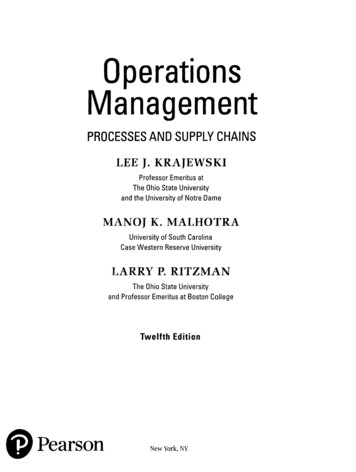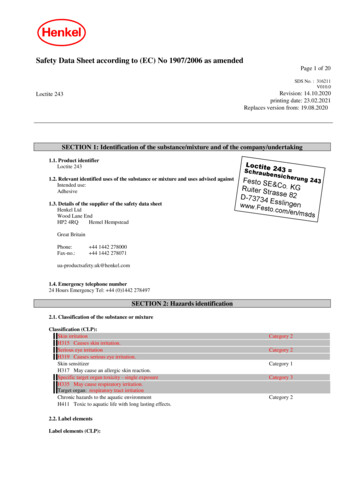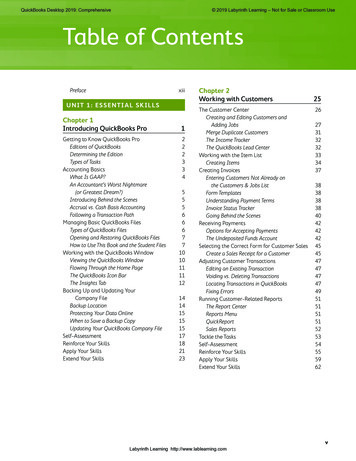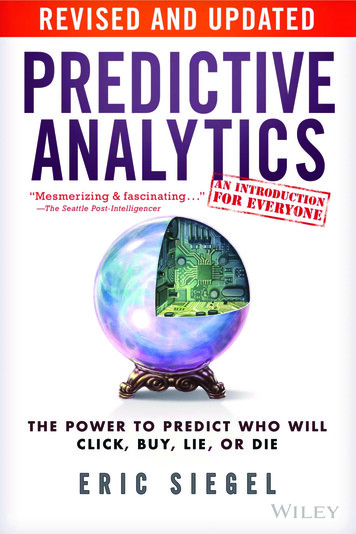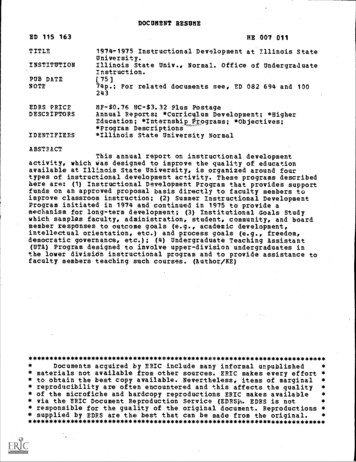
Transcription
DOCUMENT RESUMEED 115 163TITLEINSTITUTIONPUB DATENOTEHE 007 0111974-1975 Instructional Development at Illinois StateUniversity.Illinois State Univ., Normal. Office of UndergraduateInstruction.[ 75]74p.; For related documents see, ED 082 694 and 100243EDRS PRICEDESCRIPTORSIDENTIFIERSMF- 0.76 HC- 3.32 Plus PostageAnnual Reports; *Curriculum Development; *HigherEducation; *InternshipOrograms; *Objectives;*Program Descriptions*Illinois State University NormalABSTRACTThis annual report on instructional developmentactivity, which was designed to improve the quality of educationavailable at Illinois State University, is organized around fourtypes of instructional development activity. These programs describedhere are: (1) Instructional Development Program that provides supportfunds on an approved proposal basis directly to faculty members toimprove classroom instruction; (2) Summer Instructional DevelopmentProgram initiated in 1974 and continued in 1975 to provide amechanism for long-term development; (3) Institutional Goals Studywhich samples faculty, administration, student, community, and boardmember responses to outcome goals (e.g., academic development,intellectual orientation, etc.) and process goals (e.g., freedom,democratic governance, etc.); (4) Undergraduate Teaching Assistant(UTA) Program designed to involve upper-division undergraduates inthe lower divisidn instructional program and to provide assistance tofaculty members teaching such courses. ********************************Documents acquired by ERIC include many informal unpublished* materials not available from other sources. ERIC makes every effort ** to obtain the best copy available. Nevertheless, items of marginal ** reproducibility are often encountered and this affects the quality ** of the microfiche and hardcopy reproductions ERIC makes available** via the ERIC Document Reproduction Service (EDRS). EDRS is not* responsible for the quality of the original document. Reproductions ** supplied by EDRS are the best that can be made from the ******************************
1974-1975InstructionalDevelopmentat Illinois State UniversityOffice of Undergraduate InstructionInstructional Development ProgramU.S. DE PARTME NT OF HEALTH.EDUCATION A WELFARENATIONAL INSTITUTE OFEDUCATIONTHIS DOCUMENT HAS SEEN REPRODUCED EXACTLY AS RECEIVED FROMTHE PERSON OR ORGANIZATION ORIGINATING IT POINTS OF VIEW OR OPINIONSSTATED DO NOT NECESSARILY REPRESENT OFFICIAL NATIONAL INSTITUTE OFEDUCATION POSITION OR POLICY.O2
ContentsPrefaceInstructional Development ProgramBrosnahan, L.: LANGUAGE AND READING 101: AN EXPERIMENT INREMEDIAL COMPOSITION AND READING4Chasson, R 35 MM, BOTANY LAB4Chizmar, J.: COMPUTER INTEGRATED AND COMPUTER ASSISTEDINSTRUCTION IN ECONOMICS4Chrudimsky. W FILM FOR EXPERIMENTALUNIVERSITY STUDIES COURSEDodd, C.: TEACHER-LEARNER PACKAGES,BASIC MATHEMATICS INSTRUCTION5Easson, R. VISUAL MATERIALS FORTHE POETRY OF ROCK5Eimermann, T.: SUPPORT SERVICES FORPARALEGAL EXPERIMENT6Goebel, B THE DEVELOPMENT OF A COMPUTERASSISTED INSTRUCTION PROGRAM FOR EDUCATIONALMEASUREMENT6Goodall, R SELF-INSTRUCTIONAL PACKAGES INMEASUREMENT AND EVAULATION6Hall, J. DIALOGUE INSTRUCTION IN BUSINESSCOMMUNICATIONS: A CASE APPROACH7Loftier, M COMPUTER ASSISTED INSTRUCTIONMEASUREMENT AND EVALUATION I7Lorber, M. STATUS DETERMINATION PROGRAM7Marlow, J.: WAYS OF LOOKINGAS RESPONSE TO ENVIRONMENTSMead, W. XEROXING AND BINDING OF TYPEDTRANSCRIPTS FOR EXTREMIST TAPE COLLECTION8Mills, F THE DEVELOPMENT OF INDIVIDUALIZED CREDIT AND NON-CREDITART HISTORY COURSES FOR UNIVERSITY STUDENTS ANDINTERESTED COMMUNITY CITIZENS9Moore, B.: UPDATING THE SOLICITATION MATERIAL FOR THEINTERNATIONAL COLLECTION OF CHILD ART9Nelson, T.: FURTHER DEVELOPMENT OF A SELF-PACED INSTRUCTIONALOPTION IN PHILOSOPHY OF EDUCATION THROUGH COMPUTERASSISTED INSTRUCTION9(0;.1
Neu leib. J.: DEVELOPING A CASSETTE MEDIA BANKFOR FANTASY LITERATURE10Palmer, G.: SELF INSTRUCTIONAL MATERIALS FOR STOCKMARKET SERVICES IN MILNER LIBRARY10Palmer, T.: INDIVIDUALIZED INSTRUCTION UNITS FOR"DECISION MAKING FOR CONSUMERS"10Rayfield, J.: DESIGN AND ADMINISTRATION OF SIMULATIONSFOR CLASSROOM USE IN TEACHING U.S. HISTORY10Retzer, K.: PROTOCOL MATERIALS ON STRATEGIESFOR TEACHING MATHEMATICS11Sagebiel, J.: VIDEOTAPING LIVESTOCK PRODUCTION SKILLS11Salome, R.: AN AUDIOVISUAL PERSPECTIVE OF THEDEVELOPMENT OF ART EDUCATION IN THE UNITED STATES12Salome, R. VIDEOTAPE RECORDING TO IMPROVE CRITIQUESOF ART INSTRUCTION12Stefl, R.: THE DEVELOPMENT OF VIDEO TAPES FOR USEIN VARIOUS ART METHODS COURSES12Vanderbeck, E.: A CINEMATOGRAPHIC APPROACH TO ERROR IDENTIFICATIONIN SWIMMING: AN AID FOR NOVICE TEACHERS13Wiseman, E.: PNEUMATIC MOVING PART LOGIC INSTRUCTIONAL UNIT13Woodson, W.: JOINING THE SHAKESPEARE FILM CO-OP14Summer Instructional Development ProgramBaker R.: DEVELOPING SOCIAL AWARENESS MODULES16Balls, K.G.: REMEDIAL LANGUAGE TRAINING16Bellas, R.: HUMANITIES III & IV. "BRITISH CIVILIZATION"IMPROVING A MULTI-MEDIA INTERDISCIPLINARY APPROACH17Bommarito, J.: INDIVIDUALIZED INSTRUCTIONAL PACKAGES IN THE EDUCATIONOF THE CHILD WITH BEHAVIORAL DISORDERS17Champagne, R.: DEVELOPMENT OF A NEW COURSE: "INTERPRETIVEPROBLEMS IN TEACHING HISTORY"17Chizmar, J.: THE INTEGRATION OF COMPUTER INTEGRATED INSTRUCTIONALAPPROACHES IN THE TEACHING OF ECONOMICS18Chrudimsky, W.: DEVELOP A UNIVERSITY STUDIES COURSE"AMERICAN AGRICULTURAL HERITAGE"18Clark, G.: TELEVISED DEMONSTRATIONS FOR CHEMISTRY184
Eggan, L. PROSEMINAR AND INTERN-EXTERNSHIP FORMATHEMATICS D.A. STUDENTSEimerrnann, T PREPARATION OF PARALEGAL COURSES1919Francis, C ENERGY CONSUMPTION: A PLAN FORRESTRUCTURING AN INTRODUCTORY ENERGY ANDPOWER COURSEFritzen, B. "SOCIAL AND POLITICAL PROTEST IN MODERNGERMAN LITERATURE"Grabill, J.: HUMANISM: BEYOND SEX ROLESHustuft, D. THE DEVELOPMENT OF A PROGRAMMED COURSE FOR THEMAINTENANCE OF AUDIOVISUAL EQUIPMENT19202020Jesse, W. THREE DOCUMENTARIES ON MASS MEDIA NEWSFLOW21Jones, M. CONCEPTS OF PHYSICS BASIC TO KINESIOLOGY SERIES21Kennedy, L.: THE DEVELOPMENT OF ALTERNATIVE DELIVERYSYSTEMS FOR THE PROFESSIONAL SEQUENCEKonsky, C. INFORMATION SCIENCES INTERNSHIP PROGRAM:PERSPECTIVES, PROCEDURES, AND PROSPECTSLemke, E. DEVELOPMENT OF VIDEOTAPES ON RELIABILITYTHEORY AND PRACTICEMartin, T.: CASE PROBLEMS FOR PROFESSIONALBUSINESS EDUCATION COURSESMoore, B.: DEVELOPING AND BROADENING THE INSTRUCTIONAL ANDLEARNING CAPABILITIES OF THE INTERNATIONALCOLLECTION OF CHILD ARTOtto, A.' FEASIBILITY STUDY FOR COMPUTER USAGEIN MATHEMATICS SERVICE COURSESPritner, C.: DEVELOPMENT OF NEW SYLLABUS AND INSTRUCTIONALRESOURCES FOR "INTRODUCTION TO THEATRE"Rants, T EVALUATION AND REVISION OF THE CHILDREN'SLITERATURE COMPONENT IN THE ELEMENTARYEDUCATION PROGRAMSanders, H. THE COLLECTION AND COORDINATION OF READINGSAND AUDIO-VISUAL MATERIALS FOR HUMANITIES 100Schow, R PREPARATION OF MULTIPLE LEARNING ACTIVITIES,INSTRUCTIONAL PACKAGES AND AUDIO-VISUAL MATERIALS FOR SPECIALEDUCATION AND SPEECH PATHOLOGY; AUDIOLOGYWaimon, Margaret: TUTORIAL COMPUTER ASSISTED INSTRUCTIONPROJECT IN EDUCATIONALPSYCHOLOGY2222222323232424252526
Waimon, Morton: HIGH STANDARDS AND GOOD FEELINGS:PROPOSAL FOR CHANGE IN THEPROFESSIONAL SEQUENCE26Williams, J INDIVIDUALIZED COMPUTERIZEDINSTRUCTIONAL ASSISTANCE27Woodson, W DEVELOPING A COURSE IN "TODAY'S SHAKESPEARE" FOR NON-MAJORS. 27Institutional Goals Study29Undergraduate Teaching Assistant Program50Appendix A: 1974-75 Instructional DevelopmentProgram Application FormAppendix B: 1975 Summer Instructional DevelopmentProgram Application FormAppendix C: 1974-75 Undergraduate Teaching AssistantApplication FormIndex586164666
PrefaceThis is the third of a series of annual reports on instructional development activitysponsored by the Office of Undergraduate Instruction at Illinois State University, activitydesigned to improve the quality of education available on the campus. Innovation at IllinoisState University, 1972-73 (ERIC number EDO 82694) and Instructional Development atIllinois State University, 1973-74 (ERIC number ED 100243) report similar activity for theprevious two academic years. The nature and extent of projects described herein demonstrate a very real commitment on the part of faculty members at Illinois State to explorenew and hopefully better ways for students to learn.This report is published primarily as a communication device to inform membersof the University community and others interested in improvement of instruction of'activityundertaken in this area at Illinois State. Persons interested in further details should contactthe faculty members identified with the projects. The report is organized around the fourbasic types of instructional deVelopment activity which took place on the campus during1974-75.1. Instructional Development Program. The IDP provides support funds, on anapproved proposal basis, directly to faculty members to improve classroom instruction.These "mini- grant" proposals are submitted at any time on forms available in UndergraduateInstruction, reviewed by a faculty-student committee, with awards made on the basis of thequality of the proposal and likelihood of improving the quality of educational experience in aparticular course. The IDP application form for 1974-75 is included in Appendix A. Eachof the twenty-nine IDP projects funded this year is described briefly in material preparedby the responsible faculty member and edited for consistency.2. Summer Instructional Development Program. A limitation of the academic yearIDP program proved to be that it does not provide assigned time for faculty membersengaged in more substantial instructional program planning and development. A Summer IDPprogram was initiated in 1974 and continued in 1975 to remedy this problem by providing amechanism for more long-range development. Faculty members submitted proposals in aprocess similar to that used for summer research grants, which were then evaluated by thefaculty-student IDP Committee with awards made by Undergraduate Instruction. It was possible to fund only 30 of the 10o projects submitted. The Summer IDP application form for 1975is included in Appendix B. Each of the 1975 Summer IDP grants is summarized here in theform of brief reports prepared by the participating faculty members, again edited for consistency.3. Institutional Coals Study. The context within which instructional developmentfunctions at the University is an Academic Plan, revised annually to provide a constantfive-year projection of institutional program planning objectives. In reviewing the IllinoisState University Academic Plan, 1975-1980 for the purpose of preparing the 1976-1981version, it was determined that an intensive study of institutional goals was required. TheEducational Testing Service "Institutional Coals Inventory" was utilized to obtain a samplingof faculty, administration, student, community, and board member responses. This sectionof the report summarizes the findings of the ICI study and other relevant sources of information on the perceived goals of the University. The report is intended to serve as a guide tomembers of the Lniversity community, particularly the University Academic Planning Committee, as it prepares the University's 1976-1981 Academic Plan.4. Undergraduate Teaching Assistant (UTA) Program, A quite different approachto improving instruction was initiated in 1973-74 with the inauguration of the UTA program.This program, designed to involve upper division undergraduates in the lower divisioninstructional program and to provide assistance to faculty members teaching such courses,is fully described and evaluated in Instructional Development at Illinois State University,1973-74. A brief follow-up report on operation of the program during 1974-75 is includedhere. The general policy for the UTA program and the application form for 1974-75 isincluded in Appendix C. It should be noted that the University Curriculum Committee thisyear approved a new university-wide course (291, Seminar: Undergraduate TeachingAssistants) for use by students participating in the program.Expressions of appreciation are in order to several individuals who assisted withinstructional development activities, particularly to Dr. Eugene Jabker, Director of In-1
structional Development, and the members of the Instructional Development Committeefor 1974-75: Professors Wilma Jean Alexander (Business Education), Ed Anderson(Industrial Technology), Paul Baker (Sociology), Barry Moore (Art), Dent Rhodes (Curriculum and Instruction), and student Vicky Curtiss. This group evaluated numerous proposalssubmitted under the IDP and Summer IDP programs and helped stimulate and initiate instructional improvement projects throughout the University. Dr. Dean Hustuft from the Department of Information Sciences provided technical assistance to a variety of IDP projectsthroughout the year. Appreciation is also extended to President Gene Budig and Dean ArlanHelgeson for their support and encouragement of the program. Both Mrs. Rosemary Bauerand Mrs. Patricia Whalen in Undergraduate Instruction made invaluable contributions inassembling proposals, monitoring expenditures, scheduling meetings, and getting outnecessary reports and correspondence. The basic "thank you" is to the faculty memberswho originated and carried through the projects described, all projects designed to improvethe quality of education at Illinois State University. Their reports represent the modestbut serious attempt of one university to implement the thinking of the Carnegie Commissionon Higher Education as expressed in Reform on Campus: "We see the decade of the 1970'sas a period of innovation, as an era that provides unusual opportunities to improve thequality of academic life, and as a period when the energy for reform that has been releasedcan be combined with the spectrum of available innovations to provide more vital intellectualcommunities."Stanley G. RivesDean of Undergraduate Instruction2
InstructionalDevelopmentProgram
Language and Reading 101: An Experiment in Remedial Composition andReadingLeger BrosnahanDepartment of EnglishOne section of the introductory English course--English 101: Language andComposition- -was scheduled to accommodate students whose speaking dialect inter-feres with their reading or writing of standard English and results usually in serialfailure of the course. For some reason, the section did not make as a special sectionand was filled as a regular section. It was impossible, as in any regular section, todo the dialect contrasts proposed as the heart of the experiment. Standard Englishwas necessarily presumed and the non-standard speakers did not receive instructiondirected to their problems.Perhaps the most important conclusion resulting from this experience was therealization that students in need of remedial English may have to be identified andcompelled into remedial sections if they do not voluntarily choose to take advantageof this opportunity. Or administration and advisement must improve to bring to theattention of more students the availability of such remedial courses and the students'need to take them. Perhaps a university-wide English proficiency examination mightbe necessary.35 mm. Botany LabRobert M. ChassonDepartment of Biological SciencesThe purpose of this project was to prepare instructional packages to coincidewith the laboratory exercises currently used in the General Botany course. A packageconsists of a s:'t of slides arranged in a carousel slide tray and an audio cassette tape.All of the tape-slide packages have been placed in the Media Services instructionalmaterials center and may be checked out along with an automatic slide projector andtape recorder.General Botany is taught with two lectures and two laboratory meetings per week.Multiple laboratory sections are scheduled throughout most of the week placing a heavy.-d6inand on the laboratory facilities. The instructional packages are intended to servea two-fold function. First, to provide a make-up laboratory, presently unavailable ona regular basis, for those students who miss a scheduled meeting. Second, to providea vehicle for assessing the feasibility of providing a modified, inexpensive self-tutoriallaboratory experience for a selected group of General Botany students. The instructionalpackages would be available throughout the day providing maximum accessibility to thestudents and minimum demand upon staff time.Computer Integrated and Computer Assisted Instruction in EconomicsJohn F. Chizmar, Department of EconomicsOther Faculty Participants: Dean Hiebert, Bernard J. Mc Carney, Department ofEconomics; Kup Tcheng, Computer ServicesThe Mid-Illinois Computer Cooperative (MICC) was created in 1974-75 to providean educational computer network for five Illinois institutions of higher education includingIllinois State University. Initial funding through direct state appropriations enabled thePlacement of six terminals at each institution interactive with a Control Data Cyper 70computer located on the Edwardsville campus of Southern Illinois University. Fundsfrom the Instructional Development Program were used to lease and install an additional10 terminals for the academic year, thus, greatly increasing the University's abilityto undertake a variety of Computer Assisted Instruction (CM) projects.The Department of Economics and the Computer Center at ISU implemented:(1) Computer Integrated Instruction in an intensive course, "Introduction to Economict)4
Science" which combined philosophy of science, computer programming,statistics,and economics, in a mode involvingintensive "hands-on" computer usage; and (2) Computer-Assisted Instruction (CAI) as a complement to on-going instructional activitiesin the introductoiy Principles of Economics course offerings.The objective of full implementation of CAI was achieved by early April,withcomplete reliability being attained by 'mid-April. Student responseto reliable CAI wasoverwhelmingly favorable and plans are now underway to tigormisly test theeffective-ness of this instructional strategy.Knowledge of economics in the Computer Integrated course, as measured by theTest of Understandi.ng College Economics (TUCE), was as effectiveas in regular courseofferings. In addition, knowledge and understandingof statistics, philosophy of science,and computer programming was also achieved. The coarse is being modifiedto deleteprogramming due to time constraints and more fully integrate highly sophisticatedsimulation models of the, economy.Film for Experimental University Studies CourseWilbur ChrudimskyDepartment of AgricultureThe purpose of this project was to make an historical film to be used in anexperimental University Studies course: American Agricultural Heritage. Thetopic selected for this film was the care and the use of horses for agriculturalpurposes during the 1903's. The scenes and sound were filmed and taped at the Livingilistory Farms at Des Moines, Iowa. The intent of this film is to bring practicesof the past as close to reality as possible.Class presentations combining these historical films with agricultural artifactsin the Hudelson Museum of Agriculture appear to be a way to make history meaningfuland viable.Teacher-Learner Packages, Basic Mathematics InstructionCaroll Dodd, Department of MathematicsOther Faculty Participants: Keith Stearns, Department of Special EducationThe purpose of this project was to provide participants in the Special EducationJunior Semester Off-Campus experience an opportunity to develop and use materialsrelated to basic mathematics instruction.During the second semester of the 1974-75 academic year university studentsand the project staff developed teacher-learner packages in the areas ofnumeration,money and suhtraction. The packages were developed using a basic instructionaldevelopment model: for each target skill identifie
4. Undergraduate Teaching Assistant (UTA) Program, A quite different approach to improving instruction was initiated in 1973-74 with the inauguration ofthe UTA program. This program, designed to involve upper division undergraduates in the lower division instructional program and to pro


